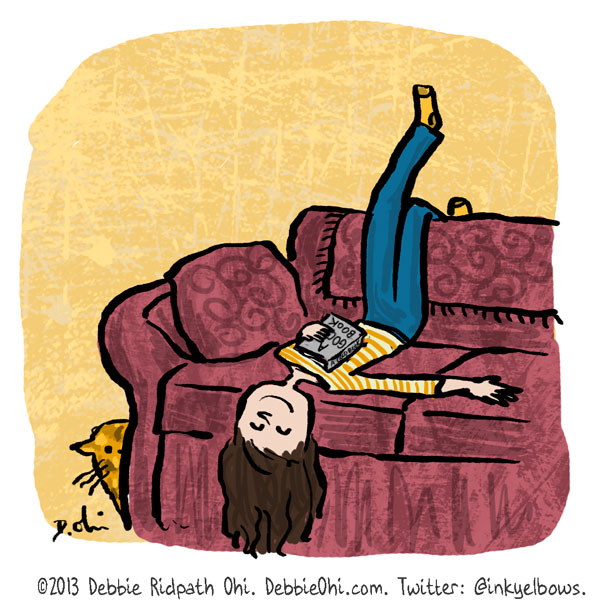Interview: Carmella Van Vleet on middle grade novels, publication, writer advice and ELIZA BING IS (NOT) A BIG, FAT QUITTER (Holiday House, launches Feb. 14, 2014)

I met Carmella Van Vleet through MiGWriters, a wonderful critique group I discovered through the SCBWI message boards. Carmella is a former kindergarten teacher and the author of numerous hands-on science and history books, including Great Ancient Egypt Projects You Can Build Yourself (Nomad Press). She loves lists, cooking shows, exclamation points, and taekwondo - but not necessarily in that order! ELIZA BING IS (NOT) A BIG, FAT QUITTER is her first novel and launches on February 14th!
I love this story and its protagonist, Eliza Bing, and can't wait until this book hits the bookstore shelves next week.
Where to find Carmella online: Website - ClassOf2k14 - MigWriters - Facebook - Twitter
ELIZA BING IS (NOT) A BIG FAT QUITTER
Author: Carmella Van Vleet
Cover artist: Karen Donnelly
Publisher: Holiday House
Launch date: February 14th, 2014
Goodreads - Indiebound - Amazon.com
Plot synopsis for Eliza Bing Is (Not) A Big, Fat Quitter:
Eleven-year-old Eliza has had many hobbies - and most of them haven't lasted very long. After she and her friend Tony create a baking business for a class project, Eliza is certain that cake decorating is her destiny. But her parents insist that the summer "Cakes with Caroline" class is too expensive, given Eliza's history of quickly losing interest in things.
Desperate to show them that she can stick with something, she volunteers to take her brother's unwanted spot in a taekwondo class. At first, Eliza has no interest in martial arts, and taekwondo is a huge challenge for her since she has ADHD. Eliza is tempted to drop out, especially when mean girl Madison shows up in class. Eliza may have set out to prove she’s no quitter, but she discovers something else: it’s okay to change your mind about who you are.
Q. What's your writing process? or What was your writing process for ELIZA BING IS (NOT) A BIG FAT QUITTER?
Carmella and her daughter.A. I spent ten years writing non-fiction before switching to fiction. I thought the transition would be pretty easy, but I quickly discovered that the process for writing fiction - at least for me - was much different. When I working in non-fiction, my drafts were outlined and completed on a set-in-stone schedule. And often times with the television or my three kids making noise! For fiction, I need a quiet house and plenty of room to warm up and play around. I had a rough outline for ELIZA BING IS (NOT) A BIG, FAT QUITTER but, for the most part, I was “pantser.” It was definitely a challenge to find the right voice; instead of my Teacher Voice, I had to get in touch with my Inner Middle Schooler. But once I found Eliza, she was pretty talkative. It helped, too, that much of the book was based on my daughter’s experiences with ADHD and bullying and our taekwondo training.
Carmella's office, where the magic happens!
From idea to ready-to-submit-to-agents, the book took about two years. (I’m not a fast drafter; I’ve learned to accept that. One of the most important things you have to remember is not to compare yourself to other writers.) Part of the process was working with my critique partners, the MiGs to get feedback. I also made the decision to work with freelance editor Diane Bailey. She was able to bring a fresh, critical eye to the manuscript. I’m not suggesting every writer needs to spend the money to hire a freelance editor but for me, and for that particular project, it was I needed to get my writing past “good” and into “good enough for publication” (In the interest of full disclosure, Diane and I are friends.)
Carmella signing her book contract
Q. How did ELIZA BING IS (NOT) A BIG FAT QUITTER get published?
A. I found my agent the old fashioned way - through lots of research and rejections. I got pretty close with a couple of agents before I found Marie. She was new to agenting, so I like to joke that I was just waiting for her to show up to the party. “The Call” is actually kind of a funny story.
Carmella with her agent, Marie Lamba (The Jennifer De Chiara Literary Agency)I’d been sending out my book for a while and getting pretty discouraged. Maybe I wasn’t cut out for this fiction stuff. You know? Around that time, my publisher contacted me about doing another non-fiction book for them. I was at a crossroads. Go back to non-fiction, which I loved and enjoyed success with, or keep pursuing my dream of writing fiction? One morning, I asked the Universe for a sign. I said, “And please make it something big since I’m dense sometimes!” Later in the day, I decided to draft a letter to my editor, turning down the non-fiction contract. I just wanted to see how it would feel. Right in the middle of typing, the phone rings. I can see from caller ID that it’s Marie and knew right away why she was calling. I thought, “Okay, Universe! I get it!” I’m sure Marie had no idea what to think when I answered the phone laughing!
Once I signed with her, I did a few more revisions and then we were ready to submit to publishers. We got positive feedback, but it was maybe eight weeks or so before an offer came. After I called my husband and parents and a close friend (all sworn to secrecy of course), my daughter went with me to buy a cake. I also treated myself to some fancy nail polish. It wasn’t until I was half way home before the irony hit me. You see, my main character gets herself into big trouble because of an incident with nail polish!
The editing process went very well despite an early bump in the road. The editor who originally made the offer, left the publishing house. (It happens sometimes.) But I was quickly adopted by another editor who loved Eliza just as much as I did and took very good care of the both of us. Julie was terrific and I agreed with almost everything she suggested, so things went quickly and smoothly.
One of the best parts of the process was when I went to New York (I was there for a SCBWI conference) and got to meet the folks at Holiday House in person. Everyone was so kind and welcoming. And I was humbled to discover that everyone in the small house was familiar with my book. Plus, I got to meet Eliza’s first reader, Assistant Editor Sally Morgridge. I wanted to give her a bear hug her or buy her a car or something, but for the record, I acted professionally. LOL.
Galleys for ELIZA BING
Q. What advice do you have for aspiring middle grade writers?
A. My best advice for middle grade writers is to do whatever you can to remember or get yourself back in touch with your kid-self. Read old journals, look at yearbooks or photos or videos. Ask your parents or siblings if they remember any stories about you. Middle schoolers are funny, thoughtful, curious and open. But at the same time, they’re under tremendous pressure to “fit in.” They’re much wiser than many people give them credit for, too. Don’t preach or teach - reach for them. And show up with honesty and a good sense of humor.
While it’s not absolutely necessary, hanging around middle schoolers is a good way to get inside their world. Listen to the way they talk, what they’re talking about (or not talking about) and how the interact with each other. This might mean volunteering to be the carpool parent or dance chaperone. If you don’t have pre-teens of your own, borrow a friends or coach or sit down at the food court at your local mall and eavesdrop.
My other piece of advice is to catch middle schoolers reading and pick their brains. For example, I train at a a taekwondo school. There are lots of kids around and whenever I see one reading a book, I make a point to ask them about it. Are they enjoying it? Is there anything they wish they could change? What made them pick up the book in the first place? The point isn’t to quiz them but to open up a conversation between readers. Because that’s what all writers should be first and foremost - good readers.
Q. What are you working on now? Any other upcoming events or other info you'd like to share?
I’m happy to announce that I recently signed a deal for my first picture book. TO THE STARS!, which I co-authored with astronaut Kathy Sullivan, will be released in 2016 from Charlesbridge Publishing. It’s about how Dr. Sullivan’s curiosity and love of science led her to become the first American women to walk in space and uses this really cool back-n-forth format.
I’ve recently finished writing a young adult novel as well. I’m hoping we can start submitting to publishers soon.
I’m also hoping to speak at writers’ conference about the rewards and challenges of writing in multiple genres and other topics. So if there’s anyone out there who needs a speaker...please contact me via my website. I’d love to hear from you!
-------------------
For more interviews, see my Inkygirl Interview Archive.













 Tuesday, February 4, 2014 at 10:08 AM
Tuesday, February 4, 2014 at 10:08 AM











































































































































